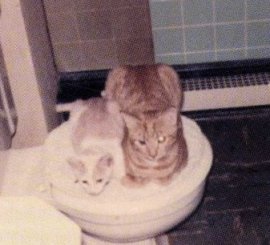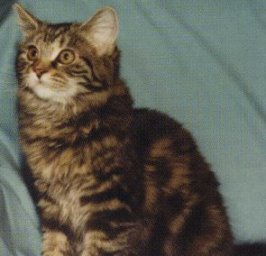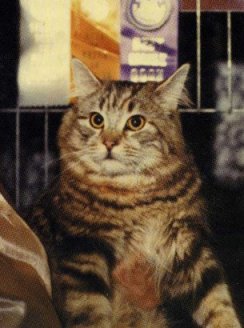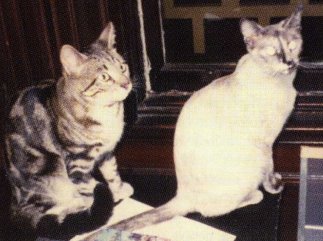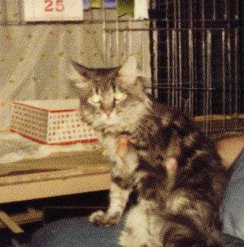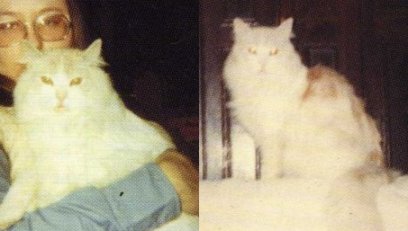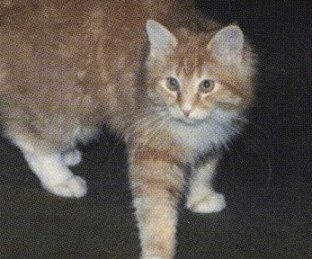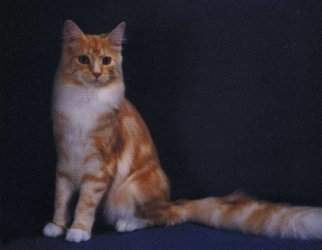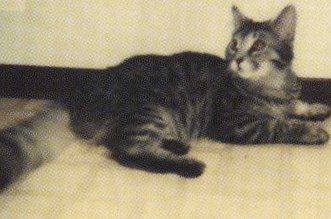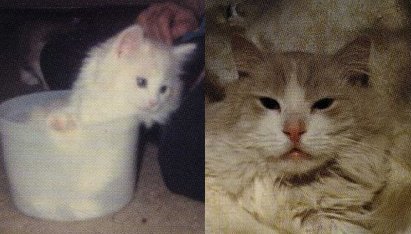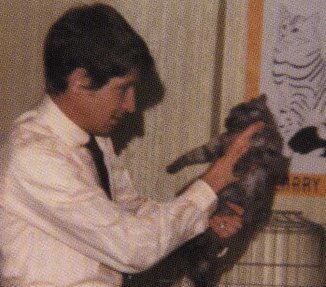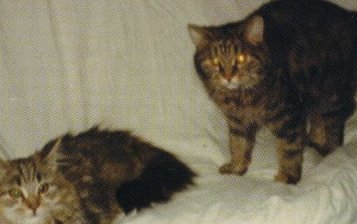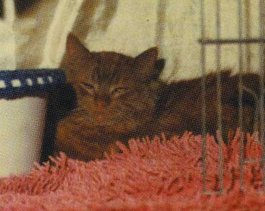| "This page was originally a part of the Maine Coon Heritage Site, a site that was first created in 1998 by Cynthia Bowen (Coontopia), Ulrika Olsson (Ylletrollets), Astrid Straver (Tricks and Tails) and Janet Marr (Furkats). It was then taken over by PawPeds, and it is now split up to fit better with the structure of PawPeds' website." |
 |
Kennebec Cattery - Love at First Sight
By Kathy Robinson, as told to Bev Caldwell
|
My first two cats: Tigger & Lovatt |
It was 1976. At that show, I started to think that the cat fancy was for me. It took me about 10 minutes to decide that I would love to breed and show cats, but I didn't have a clue about breeds. At shows and away from shows, I talked to breeders of many breeds. I visited a Korat cattery and discussed the breeding of blue to blue. Too boring for me. I visited a Burmese cattery and discussed the kitten mortality. Too appalling for me. I saw a Maine Coon and discussed nothing but how wonderful they were! It was true love at very first sight. I loved the type. I loved the coat. I loved the health of the breed. I loved that there happened to be a Maine Coon Breeder in my hometown!
|
Orchard Cricket of Kennebec |
I visited Marion Lively of Orchard Maine Coons in Pittsburgh, PA, and was immediately smitten with Cricket, a beautiful torbie (brown patched tabby). I had to have her even though I knew that only ACFA accepted the color for Championship at the time. Graciously, Marion accepted payment over time for Cricket, and I was able to bring her home with me in the summer of 1976. Cricket became my cattery's first breeding queen.
It seemed to me that a cattery name for Maine Coon Cats should reflect somehow on the state of Maine, but I didn't want it to sound too specific since someday perhaps I'd decide to work with another breed. I chose the name Kennebec in honor of an Indian tribe in the great state of Maine. It's also the name of one of Maine's largest rivers which flows south all the way from Moosehead Lake in Northern Maine to the Atlantic Ocean. I first registered with CFA on the theory that if CFA accepted it, I could get it in the other associations - not wanting to have different names on the pedigrees. I added CFF later (there was a club in Pittsburgh at the time) and a little later added ACFA. TICA did not yet exist, but I am now registered with TICA as Kennebec as well.
|
CH Stonehill Japeth |
Soon after Cricket joined our household, my husband, Jack, and I attended the World Science Fiction Convention which was held in Kansas City that year. Knowing that we were going to Kansas City, Marion had suggested we contact Maxine Lenz of Stonehill Maine Coons. Maxine and her daughter, Jan Gustafson, lived in Lees Summit, MO, which is very dose to Kansas City. We did contact them, and Jan came over and picked us up at our hotel. We had a wonderful time visiting the cattery and chatting all afternoon. I purchased my first stud at that time, a brown tabby kitten who would grow up to be CH Stonehill Japeth of Kennebec. Jack fell in love with an alter who was looking for a new home. He was from Stonehill's very first litter of MCs - PR Stonehill Ephraim of Kennebec, a cameo tabby with white (incorrectly registered as a cream tabby/white). Both boys arrived at the airport in Pittsburgh shortly after our return and settled happily into our Kennebec home. They were later joined by Ephraim's brother, altered CH Stonehill Amos Moses, the most brilliant mahogany red tabby I've ever seen.
We showed all of them in CFF, later in CFA, and thus began our introduction to many years in the show hall. Pittsburgh was a very active center for Maine Coon people at the time. There was Marion, me, Margie Jonnet (Margee) and Saundra Vorndran who didn't breed but actively showed her altered MCs. Marion's cats came from Lilias Vanderhoff (Norwynde), Margie's cats were from Harold Hansen (Cozy Nook), and Saundra had three cats from Liz Eastman (Ktaadn). Maine Coons did not go very far in CFA around Pittsburgh even though we all had nice, typey cats for the time, and we presented them well. As I recall, CH Cozy Nook Dinah of Margee, a beautiful black girl, earned a few grand points, and our Ephraim finalled once as a Third Best Premier in Al Lunde's Specialty Ring (back when there were only 3 places in Specialty and 5 in Allbreed). With few exceptions, those years were a long "dry spell." Often we felt our finals came when the judge (however reluctantly) hung the BOB and 2-BOB.
|
Tuffy Whitethroat, polydactyl DSH and |
Showing our cats became very disheartening when CFA opened the registry in 1978-1979 to allow unknown x unknown to be shown first generation. All of us were working very hard toward a vision of the MC as the standard was written - large, rectangular, shaggy, etc., and the judges were seeing "Maine Coons" as anything non-pointed and longhaired that wasn't a Persian. Seeing so many different types of cats being presented as MCs did not make a favorable impression on judges, to say the least, and it made things even tougher for us. Although I don't recall overhearing any nasty remarks, there were so many stories of judges calling them barn cats or household pets that one has to believe that the majority opinion about the breed was not a positive one. In addition, many of the cats were being shown by people who did not have a breeding program, did not understand what the breed was all about, and did not even know how to present a clean, groomed cat in the show ring. I know this hurt the breed and made the acceptance of the MC that much tougher. It also made it hard for us who were dedicated to the breed and who spent a great deal of time, effort and money to produce a cat that truly belonged in the show hall.
|
CH. Pa-Gar Victor K of Andyspals |
I was in the clerking program at this time and clerked at most shows I went to. The shows were just 4 rings over 2 days so there was a lot of time to "lobby" for the breed. The judges I talked with were interested in learning, but it was "a very long road" with most of them. It was obvious that many of the judges did not give the breed any respect and felt that Maine Coons did not belong in a show hall. There were times I really wondered why I bothered to spend hours bathing and grooming my cats only to watch a judge act as if s/he couldn't bear to touch them let alone give them a thorough judging.
From 1977 to 1982 the shows produced by the CFF club in Pittsburgh became a gathering place for MC people from everywhere; they were like "old home week" or family reunions. Ruth Pratt even flew in from California one year with Purrbred's Silent Stranger, a white boy who became CFA's first MC Grand Champion. (In those days it was not so common for cat people to fly all over the place to go to shows.)
Many other cats that are still in today's pedigrees (albeit many generations back) passed through the rings in Pittsburgh. Connie Condit brought her Heidi Ho cats Sonkey Bill, Henry Sayward, and Seth Parker. Ginny Molloy was there with Charmalot Bluesette. Everyone knew everyone; it was a lot of fun. We helped each other, and we encouraged and cheered on each other's cats.
|
PR Stonehill Ephraim of Kennebec, pictured 30/10/76 |
Cricket and Japeth produced only one litter before I lost Japeth to cystitis (FUS, Feline Urologic Syndrome now called FLUTD, Feline Lower Urinary tract Disease.)
This was a shock and unspeakably sad for me since both the vet and I thought we had caught this and catheterized him in time. Around this same time, Magnificat Oregano of Kennebec (registered cream/white but truly ca meo or red smoke/white) had come to live with me. Bred by Jan Spurr (Magnificat/Magnificoon) and originally owned by Jerry Cuba (Oak Glen Cattery of California), he had been bred to Pupuli Tutsi Frutsi and produced Oak Glen Orange Juice Kid and Oak Glen Caramel. These two are still seen in pedigrees today.
As a side note, there are a few reasons for the registration discrepancies for Ephraim and Oreo, and I'm sure many others, too. One reason was that no one really understood the Inhibitor gene and especially not when it combined with the 0 (red) gene. Another was that the "real" colors weren't showable at the time; the cats were "mis-registered" when I got them. Oreo bred as a dominant solid when bred to a solid black girl, giving me solid black, smoke tortie and a calico. When bred to Cricket, he produced some kittens that were silver mctabby and some red mctabbies as well. Oreo was pretty short and round by today's standards, but his temperament and personality could not be beaten. (Oreo is short for Oregano which would have been more appropriate if he'd been black and white, but I couldn't bring myself to call him what the Cubas did - Orgie!)
|
Tanstaafl Loki of Kennebec |
In 1979, to add type to my cats I purchased a red tabby/white boy from Beth Hicks (Tanstaafl), Tanstaafl Loki of Kennebec. I never did get a kitten from him because just as he was getting old enough to sire, I was in the midst of having my own babies and starting a family of my own. My first child was born in 1981. I carried on with the cats for another year, but I could not do justice to both my human family and my cat family so I left the fancy in 1982. (A friend who leased Loki for awhile did have a litter or two from him, but I don't believe anything by him was ever used in anyone's program. This is my biggest regret from "the first time around" with my cattery - that none of my cats really contributed to the breed.)
In the years that followed, some strange sets of circumstances left me with several cats with URIs that couldn't be controlled; I lost some of my cats at this time and placed many others. I kept a few of my MCs and a few HHPs until 1987 when the last of my first crew passed on to Rainbow Bridge. After 6 months, I couldn't stand being catless and adopted a black DSH and a black and white DLH. Inki died last spring at 16 or so, and Abigail is still with us, fat and sassy.
In 1995, I visited a cat show for the first time in 14 years. I wandered around in awe at the quality of the Maine Coons. I saw Bill Lee judging in a ring; happy memories of years before, clerking for him and discussing the breed, crowded into my mind. Smiling at those happy thoughts, I sat and watched his finals. Then it happened. I think it was his second best cat. He put GRC Thecathut Dizzy Gillespie on the table, and that did it. I was hooked all over again, and my life would not be complete until there were Maine Coons in it once more.
|
Kennebec Melchizedek, DOB 1/2/98, Cameo |
It took me until the fall of 1996 to find a cat, and he was CH Blueblaze Silverado of Kennebec (silver tabby). I was just going to show him in premiership, but he was so nice and when his breeder said it was OK to breed him (thanks, Elektra!), I really "caught the bug" again. Since then, I've added several girls and now have cats of my own breeding. In addition to Blueblaze, my cats are from Pittsburgcoon, Navkatz, and Canongate. But if I were starting off for the first time, or if I were to advise a new breeder, I would say to spend some time showing in premiership. I'd also say to do lots of reading, homework and research and talk to many people before committing to breeding or buying the first breeder. I also think it's good to have more than one mentor and to talk to as many people as possible. The more people you talk to, the more you learn and also you benefit from many different perspectives. I don't believe in limiting yourself to one source of information. As a breeder, I've found it very important to stay close to breeder friends; sharing cat-bath time and shows is helpful. It's good to have a couple of breeders you can use as "sounding boards". Everyone needs to talk things over now and then.
|
Kennebec kitten, pictured 3/80 at about 6 |
Today's Maine Coon classes are quite different from my early days in the fancy. When I started, there were a lot of bi-colors and blue tabbies and cream tabbies; today, I'm shocked to see so little diversity in color (although that is changing) so I am actively trying to show every color but brown. I am especially interested in the silver, smoke and cameo colors, but I am more interested in "building the barn, then painting it" - breeding solid, healthy cats first then worrying about colors. My vision of the "perfect MC" has not changed much over the years. I like a muzzle that looks like it ran into a brick wall, and I detest undershot chins. Ear placement is important, and I like big ears with tips and tufts. But overall, I like a well-balanced cat, a look right in the middle between "sweet" and "feral". Nowadays, the cats are much more uniform in type and much closer to the vision the early MC breeders had; what seems to have changed the most are the people with the cats. I see cliques and snubs, downright rudeness and discourtesy among the people involved with the breed. In my opinion, these attitudes and behaviors do not help the MC at all.
I love showing, and I like to show my breeders to CH at least. You get to see their show temperament, and I think it's valuable to have other people's opinions about my cats, how well they meet or why they don't meet the standard. I like showing my kittens, too. That way, if a kitten turns out well, he is accustomed to the show hall. I haven't found it easy to tell early on whether or not a kitten will meet the standard and be top show. Sometimes you can get some clue but only time and growth will tell for sure. The kitten that looks promising at 3 months may never develop further while a littermate surprises you and becomes stunning as an adult. We all have some gorgeous show cats living in great home lives as beloved pets with people who have never been to a cat show - with or without a cat!
|
PR Stonehill Ephraim of Kennebec, DOB 11/10/73, Cream |
My greatest frustrations with showing are the politics and the attitudes noted above although I mostly ignore these things. This is my hobby. I love to talk to other cat people and to show off the cars that I have bred. Still, showing is not the end-all goal. Breeding healthy, wonderful companions who are great representatives of the Maine Coon breed is the goal, and whether or not my cats would ever be shown again is certainly no indication that they could or could not contribute to the breed.
Whether or not to breed from cats with faults - it certainly depends on the fault. A beautiful cat with a locket, well, it would be a shame not to use him/her. A cat with a genetic tail fault is probably not worth it, but I try never to say never. As to the question of foundation cats, I do believe there is still a place for them in breeding programs though certainly not first generation being showable. I have heard that the ASH people have a good program for getting foundation blood into their pedigrees - some standards in place but not too restrictive. As to line-breeding or outcrossing, I will say that, looking at the overall status of the breed now, I am very leery of close inbreeding. Doubling up on a certain ancestor can probably be okay as long as the overall genetic diversity is not sacrificed. When I started studying pedigrees after a gap of fourteen years, it truly amazed me to see how constricted the gene pool appears with certain cats being overused. (Breeders of other breeds tell me that they have the same situation.) At any rate, I am very careful with my pedigrees and am trying to keep as much diversity as possible.
|
Kennebec Fantasia, Smoke Tortie Female, |
My cats have the run of the house, under foot, on top of counters, lounging on the sofa - you name it. However, I do keep the boys in separate rooms, and of course, as the girls come close to kittening, they are sequestered in my bedroom. In my breeding career, there have been no real high points yet, but low points happen every time a cat is sick or I lose a kitten. I have placed some cats in breeding homes in recent years, and I hope that the Kennebec name will be in pedigrees down the line. One smoke tortie kitten from Oreo and Stonehill Mimi of Kennebec went to Canada, but I have lost track of her. If anyone has information on Kennebec Fantasia I would be delighted if they would contact me.
Oh, and my Mom? She is still allergic to animals, and when she comes to visit, she doesn't stay for any length of time. Mom's never been very thrilled about my cats, but then she wasn't too thrilled when I got pregnant for the third time either. It's difficult to realize your dreams if you live a life that someone else thinks you should live, so rather than let anyone lay guilt trips on me, I just do what I feel is right for me and don't let others' "shoulds" or "shouldn'ts" bother me.
|
CH. Stonehill Japeth of Kennebec, DOB 15/6/76, |
A downside to current breeding is the health problems that have become apparent such as hip dysplasia (HD) and hypertrophic cardiomyopathy (HCM). The first time around, I had no clue that there were such things. Part of this, of course, was that no one knew then what they know now; there have been incredible advances in feline health research and knowledge in the past several years. Sadly, however, part of it may be that the degree of inbreeding (that gave us that uniformity of type) has brought what were relatively uncommon and rarely seen health problems to the forefront. The setting of type is what Connie Condit did so well - if only the breeders who used her cats had outcrossed and outcrossed again. If you study pedigrees, you find that everyone started their lines with some fairly intense inbreeding although later they outcrossed and outcrossed again. The bottom line is that we need to be very careful what is bred to what, or the wonderful vitality we've come to know and love in our Maine Coons may be lost forever. Since my primary goal is to maintain that vitality, I test Kennebec breeding cats for HCM and HD as time and money allow.
|
Altered Ch. Stonehill Amos Moses, |
In general, I find that today's Maine Coon is what we wished for the breed when we were working with fifth and sixth generation cats: large, rectangular bodies; long, flowing tails; square muzzles and well-placed big ears with wonderful tips and tufts. A real thrill in the show hall today is that Maine Coons make finals. I think they should make more, considering the popularity of the breed. That said, however, I think too many breeders sacrifice health for show wins.
I would say that health concerns, the specter of HD and HCM, and the tangle that some pedigrees are in must be of greatest concern; it is my opinion that breeders must sincerely begin to take responsibility for the vitality, health, and the very survival of the Maine Coon Cat. If we won't, who will?
|
Kennebec Cattery would not have existed in either incarnation without the support and loving tolerance of my husband. Jack. He likes the cats (though he thinks cat shows are like watching paint dry), but he has a distinct dislike for certain obnoxious smells. I guess he realizes what part the cats play in keeping me sane and doesn't complain too much about the cat hair on his suit pants! Now that my kids are 18,16 and 13, they help me with the cats. Well, they help love and socialize the kittens, but I have to practically sneak kittens that are sold out the door when they aren't looking. Also, I must thank Lynda Kaczmarski of Pittsburgcoon who gave me two of my first queens when I started over. I value her advice in planning future matings, and she's the one who's always there to help with cat baths, to share in traveling to shows, and to be a very good friend. |
© "Maine Coon International", issue 20, 1999.
Reprinted with permission.

